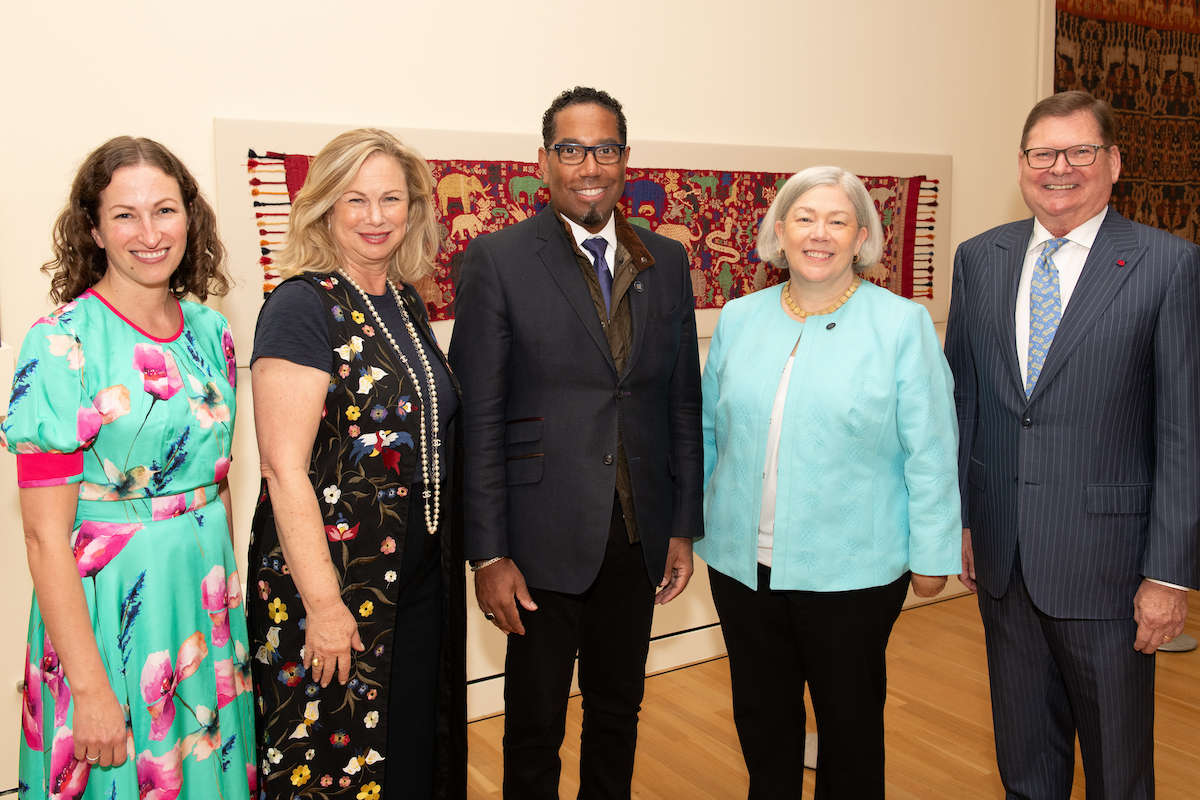At first glance, the child’s kimono hanging on the second floor of The George Washington University Museum and The Textile Museum might seem beautiful but demure. Its indigo-and-white color scheme would have been appropriate for a non-titled family during Japan’s Meiji period, when it was made—certain colors were forbidden to these families—and its pattern is a relatively simple repeating one.
But to those who know how to look, there’s an opulent, complex secret to the garment’s construction—emblematic of the way families like this child’s were rising to prominence despite their society’s rigid class structure. The plaid-like hash patterns between clouds of white peony were created by ikat, a sophisticated technique requiring the weaver to know with mathematical certainty how a pattern will lie on a piece even before dyeing the thread that will construct it. It’s done by master artisans, and it’s expensive. Without apparent ostentation, the garment says: Look how well we can afford to clothe our children.
The kimono is one of many pieces showcasing the resist dyeing technique at The George Washington University Museum and The Textile Museum’s latest exhibition, “Irresistible: The Global Patterns of Ikat.” It runs through June 1.
In ikat, bundles of yarn are tightly tied off in predetermined patterns that resist absorbing the dye when immersed. This process can be iterated as many times with as many colors as the weaver’s imagination and ability allow. These patterned yarns are then lined up on a loom in one of three weaving techniques: as warp ikat, weft ikat or double ikat.
In warp ikat, the dye-patterned threads are strung directly onto the loom so the pattern is visible in the setup. The weaver then uses a shuttle strung with solid-colored thread—the weft—to finish the fabric, drawing the pattern together without significant alteration from its unwoven form. In weft ikat, conversely, the artist strings the loom with solid-colored thread and applies the dyed strands back and forth across them. Double ikat, as the name suggests, uses both techniques at once.
“It’s complicated, because you have to have the idea in your mind of what your pattern is going to be before you even dye it,” curator Lee Talbot said. “And yet all over the world there are pockets of people who figured it out.”
The oldest extant ikat textiles are about 1,300 years old—and the oldest in the exhibition is around 1,000—but that suggests more about the difficulty of conserving textiles than about the age of ikat dyeing itself, Talbot said. The technique preserved on those surviving pieces is sophisticated enough to suggest millennia of previous development.
Often, ikat spread the way most fabrication techniques do—either from a common ancestral practice or via trade and cultural exchange. Much ikat in Southeast Asia, Talbot said, appears to have originated in Southern China before moving with emigrating inhabitants to the Philippines and Indonesia about 2,500 years ago. Ikat in areas along major trade routes reflects the connections those routes would indicate, as in figurative weft ikat, which might depict lines of elephants in pieces from India or of regal human figures in pieces from Bali. The influence of a Gujarati ikat form called patola, which features bars of solid color framing a patterned field, is reversed in a hip wrapper from Cambodia with a jewel-green central field and patterned border.
But many regions appear to have developed these techniques independently. “Irresistible” features pieces made around the same time in Yemen and in Peru during an era when the Middle East would have had no contact with the Americas. And while many pieces feature similar motifs—particularly diamond and chevron shapes—not all similarities indicate contact, Talbot said. Ikat lends itself to these shapes, especially warp ikat, since a square block of undyed thread could be tugged into a chevron on the loom with relative ease.
Because of its complexity and the degree of conceptual thinking its construction requires, ikat often served as a status symbol and commanded high prices. But some cultures’ ikat would never have been sold: the high status these pieces indicated was spiritual. Items on display in “Irresistible” include a Lao “spirit skirt,” given to a woman when she married so she would be recognized and welcomed in the afterlife by her deceased in-laws. Another elaborate piece, made among the Iban people of northwestern Borneo, denotes its maker’s spiritual power by the complexity of her work and the animal figures she was confident enough to depict. When hung in the artist’s home, the textile’s richness created a space within which the gods felt sufficiently honored to speak.
Some techniques are difficult for non-weavers even to grasp, despite the illustrative videos included in the exhibit. The Meiji child’s kimono, for instance, was created using a stack of razor-thin wooden boards the exact width of the maker’s loom, with the repeating pattern painted onto the boards’ side. The weaver would then unstack them in order, place a long strand of string next to the unstacked boards and mark it in the places indicated by the deconstructed painting. This marked string would be used to wrap the bundles of thread for dyeing, resulting in a long, apparently abstract weft that, when woven, reconstitutes the painted pattern in cloth.
That may seem a long way from the v-patterned warp construction that ikat takes in its most basic form. But Talbot says the difference is indicative of the way human ingenuity and imagination develop in every era and region.
“Ikat is an ancient tradition that unites people all over the world; in some ways, it's a common denominator that we all have,” Talbot said. “And yet each culture has its own unique expression of it. We can see similarities, but we can express our differences, too.”
“Irresistible: The Global Patterns of Ikat” is on view at the GW Museum and Textile Museum through June 1. See the museum’s website for visiting hours and more information.





